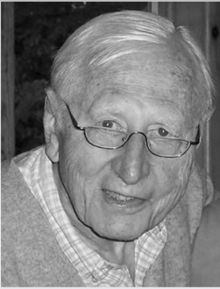Quentin Gibson
Professor Quentin Gibson | |
|---|---|
 | |
| Born | Quentin Howieson Gibson 9 December 1918 Aberdeen, Scotland |
| Died | 6 March 2011 (aged 92) |
| Citizenship | British, American |
| Education | Queen's University Belfast |
| Spouse | Audrey Jane Pinsent |
| Children | 4 |
| Awards | Fellow of the Royal Society (1969)[1] |
| Scientific career | |
| Fields | Biochemistry of heme proteins |
| Institutions | University of Sheffield Cornell University University of Pennsylvania |
| Notable students | Keith Moffat[2] |
Quentin Howieson Gibson
Education
Gibson earned a
Life
Gibson taught at the
Research
Hemoglobin
Gibson started his career with studies of hemoglobin,[7] [8] and continued with much other work on heme proteins.
Medical and physiological work
In keeping with his medical qualifications, much of Gibson's early work[9] [10] had medical or physiological relevance.[11]
Cooperativity
During the period when protein and enzyme cooperativity was at the center of biochemical interest Gibson studied it in the context of abnormal hemoglobins.[12] [13]
Rapid reactions
Gibson made major contributions to the development of methods for studying rapid reactions,[14] and their application to hemoglobin.[15]
Other proteins
Other work concerned enzymes such as "diaphorase",[16][17] glucose oxidase,[18] cytochrome oxidase[19][20] and peroxidase.[21]
Thermodynamics
Much of Gibson's work concerned questions of thermodynamics and equilibria, and in that context he participated in discussions about how to present thermodynamic data.[22]
Awards and honours
Gibson was elected a Fellow of the Royal Society in 1969.[1] He was also a member of the National Academy of Sciences, and an associate editor of the Journal of Biological Chemistry from 1975 to 1994.[23]
References
- ^ .
- ^ "Quentin H. Gibson's Profile on Academic Tree".
- ^ "Quentin H. Gibson". Cf.ac.uk. Retrieved 21 December 2011.
- ^ "Notices 2011". Royal Society. Retrieved 21 December 2011.
- ^ Bretscher, Anthony. "Audrey Jane Gibson" (PDF). ecommons.cornell.edu. Cornell University. Retrieved 27 March 2017.
- ^ Olson, John. "Retrospective: Quentin H. Gibson". Asbmb.org. Retrieved 21 December 2011.
- PMID 16747706.
- PMID 16748235.
- PMID 15410128.
- PMID 14838861.
- S2CID 87448894.
- PMID 171411.
- PMID 13429517.
- PMID 5833381.
- PMID 13628568.
- PMID 13767908.
- .
- PMID 14257628.
- PMID 14275150.
- PMID 6315412.
- PMID 5442280.
- S2CID 96307963.
- ^ "Volume 250 Issue 24 pages 9215-9438 (J. Biol. Chem.)". 1975. Retrieved 14 April 2021.
